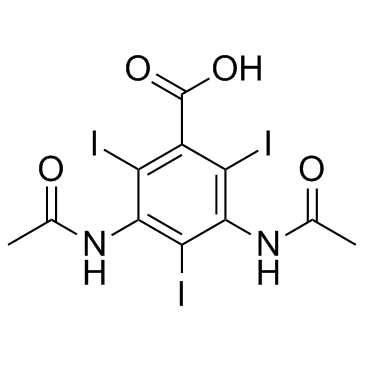Diatrizoic acid

Diatrizoic acid structure
|
Common Name | Diatrizoic acid | ||
|---|---|---|---|---|
| CAS Number | 117-96-4 | Molecular Weight | 613.914 | |
| Density | 2.7±0.1 g/cm3 | Boiling Point | 720.2±70.0 °C at 760 mmHg | |
| Molecular Formula | C11H9I3N2O4 | Melting Point | >300ºC | |
| MSDS | Chinese USA | Flash Point | 389.4±35.7 °C | |
|
Biodegradation of pharmaceuticals in hospital wastewater by staged Moving Bed Biofilm Reactors (MBBR).
Water Res. 83 , 293-302, (2015) Hospital wastewater represents a significant input of pharmaceuticals into municipal wastewater. As Moving Bed Biofilm Reactors (MBBRs) appear to remove organic micro-pollutants, hospital wastewater was treated with a pilot plant consisting of three MBBRs in ... |
|
|
Bone metastases in castration-resistant prostate cancer: associations between morphologic CT patterns, glycolytic activity, and androgen receptor expression on PET and overall survival.
Radiology 271(1) , 220-9, (2014) To compare the features of bone metastases at computed tomography (CT) to tracer uptake at fluorine 18 fluorodeoxyglucose (FDG) positron emission tomography (PET) and fluorine 18 16β-fluoro-5-dihydrotestosterone (FDHT) PET and to determine associations betwee... |
|
|
Optimization of culture conditions for bone marrow stromal cells in RPMI-1640 medium.
Rev. Med. Chir. Soc. Med. Nat. Iasi. 116(1) , 222-7, (2012) Bone marrow mesenchymal stem cells are important for both research and clinical purpose. A number of culture methods for these cells are available on the market, many of them consisting of specialized growing media in combination with growth factors. Our goal... |
|
|
Histopaque provides optimal mouse islet purification kinetics: comparison study with Ficoll, iodixanol and dextran.
Islets 3(4) , 144-9, (2011) Islet transplantation has become a very promising treatment for type 1 diabetes. To facilitate further clinical improvements in this exciting field, rodent islets are used to evaluate new strategies and modifications. One method to purify islets is on a densi... |
|
|
Effective hydrodynamic shaping of sample streams in a microfluidic parallel-plate flow-assay device: matching whole blood dynamic viscosity.
IEEE Trans. Biomed. Eng. 59(2) , 374-82, (2012) We report the development of an aqueous buffer system tailored to the fluidic and hemodynamic requirements of our recently reported microfluidic platelet dynamic assay device, which uses hydrodynamic focusing to "shape" a blood sample into a thin flowing laye... |
|
|
The influence of selected techniques of bovine leukocyte isolation on their viability and metabolism.
Pol. J. Vet. Sci. 14(4) , 663-5, (2011) The aim of the study was to assess the effect of selected isolation methods on the viability and metabolism of bovine leukocytes. The cells were isolated using a Ficoll 1077, Histopaque 1083 gradient and osmotic shock method, and Ficoll or Histopaque with osm... |
|
|
An Assessment of the Optimal Time for Removal of Esophageal Stents Used in the Treatment of an Esophageal Anastomotic Leak or Perforation.
Ann. Thorac. Surg. 100 , 422-8, (2015) Esophageal stent for the treatment of a perforation or anastomotic leak has been shown to be effective and safe. However, the optimal timing for stent removal is in question. This purpose of this investigation was to identify a time for stent removal in patie... |
|
|
Doping of biogenic Pd catalysts with Au enables dechlorination of diclofenac at environmental conditions.
Water Res. 46(8) , 2718-26, (2012) By using the metal reducing capacities of bacteria, Pd nanoparticles can be produced in a sustainable way ('bio-Pd'). These bio-Pd nanoparticles can be used as a catalyst in, for example, dehalogenation reactions. However, some halogenated compounds are not e... |
|
|
Biogenic palladium enhances diatrizoate removal from hospital wastewater in a microbial electrolysis cell.
Environ. Sci. Technol. 45(13) , 5737-45, (2011) To decrease the load of pharmaceuticals to the environment, decentralized wastewater treatment has been proposed for important point-sources such as hospitals. In this study, a microbial electrolysis cell (MEC) was used for the dehalogenation of the iodinated... |
|
|
Palladium nanoparticles produced by fermentatively cultivated bacteria as catalyst for diatrizoate removal with biogenic hydrogen.
Appl. Microbiol. Biotechnol. 91(5) , 1435-45, (2011) A new biological inspired method to produce nanopalladium is the precipitation of Pd on a bacterium, i.e., bio-Pd. This bio-Pd can be applied as catalyst in dehalogenation reactions. However, large amounts of hydrogen are required as electron donor in these r... |